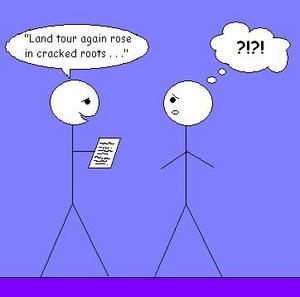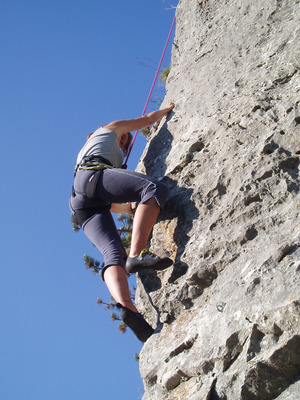Anybody who has ever read Lewis Carroll knows something about nonsense poetry. His poem entitled “Jabberwocky” is found in Through the Looking-Glass; the verse is both funny and frustrating in its nonsensical content. The beauty in nonsense seems to be that it defies the notion that everything we read and/or say must make sense.
Rather than bursting right into lessons on writing nonsense poetry, let’s give it a little twist I like to call Non-Nonsense. Non-Nonsense poetry is a fun way of creating verses whose meanings remain your little secret. To the unknowing masses, the verse may appear as complete nonsense. To you, however, the poem will never be as nonsensical as it seems. Hopefully in a moment you’ll see what I mean.
1. Pick a Theme, Any Theme. The first step to writing a Non-Nonsense Poem is choosing a topic or theme to write about. Look around you. Are there plenty of objects in your room you can write about? Head outside; what do you see? What are your favorite book titles? What did you have for dinner last night? Absolutely anything and everything, from crayon names to your record or CD collection, can be written about. For this first exercise, I chose to write about the posters hanging around my computer desk: Gene Kelly in Singin’ in the Rain, Batman and Robin, the men of The Godfather, a Pulp Fiction poster, et cetera. Once you have your topic, theme, or inspiration, you’re really ready to begin.
2. Write a First Draft. Next, you’re going to write your actual poem, the first draft. Depending on how much you have to go on, you may have just one stanza or several. Break it up however you want; it won’t really matter in the end (trust me, it really won’t). You can write phrases, short descriptions . . . whatever you feel. Let me offer you a word of caution before you start penning away. The next step will hinge on what you write now; not to give it all away, but try to make sure you choose words that you can rhyme (directly or loosely), or else the next step will give you trouble! For an example, check out my sample poem below:
I see Gene Kelly dance on a lamppost
Batman and Robin
And four men pose in black suits
A pulp fiction gritty scene about to transpire
An artist smokes and plays the keys
A superhero takes a stroll on thirty-first
A Godfather dipped in blood
I’ll be honest with you and share my falseness in the verse. The line about the superhero originally took place on Forty-Ninth Street, but for the life of me I couldn’t think of a word that rhymed with forty. Instead, I changed it to thirty-first, which sounded just as good to me and would be easier to rhyme. Feel free to tweak the reality of what you choose to write about; in the end, nobody will know unless you tell them. Be sure to give your poem a title in this step as well. It makes the end result all the more interesting if you have a title that relates to this poem. The title of my poem was “Poster War”.
3. Rhyme Time! Now comes the fun part! In this step, you’re going to take the first draft of your poem and completely turn it inside out. You’ll do this by trying to rhyme each word from your original. For example, instead of “I see Gene Kelly,” my verse became “Eye cream preen jelly.” Here is where the apparent nonsense begins; note that to anyone who read the latter line without knowing the original, it sounds like complete nonsense. Here’s the full poem I wound up writing:
Eye cream preen jelly prance don a pot roast
Jam and bobbin
Land tour again rose in cracked roots
A pulp kitchen clean without you expire
Man carts is pokes and frays the knees
A trooper mirror fakes a toll son dirty hurts
A prod bother ripped in mud
Try to create your rhymes without thinking too hard about how it looks. The more random your words are the better. Rather than worrying about whether or not two words look good next to each other, just let the words come naturally. When I wrote the above poem, I liked the words “cream preen jelly” but hated them together. The next step may take care of that for you, but don’t try to change anything now. Otherwise, your Non-Nonsense Poem may start to make too much sense!
4. Breakdown. The final step is pretty simple, and completely optional. Let’s say you’re not happy with how your poem looks. For example, I thought the very first line of my poem looked absolutely hideous as one line. In this step, all you do is break up your poem however you like. Combine lines; break them up. Destroy your original stanzas; turn one into four or two into one. Add punctuation. Do whatever you like. Do not, however, change any of your words now! That’s pretty much the only way you can “cheat” when writing this form of poetry. When you finish, you’ll have your first official Non-Nonsense Poem! Here’s my final result (note how the original title stays the same, and even adds a bit to the mystery of the poem):
Poster War
Eye cream, preen–
Jelly prance
Don a pot roast
Jam and bobbin
Land tour; again
Rose in cracked roots
A pulp
Kitchen clean without you
Expire
Man carts, is,
Pokes, and frays the knees
A trooper
Mirror fakes a toll
Son dirty hurts
A prod, bother– ripped in mud
As always, the most important thing to remember is to have fun with it. Allow yourself to gloat in the glory of your poem. Pass it out to friends and family and giggle to yourself when they have no idea what’s going on. (If you’re feeling particularly silly, try asking folks what they think your poem is about!) Or, try putting away your first draft of the poem-or even throwing them away-until even you can hardly remember what this poem was actually about! Now, go have fun with your non-nonsense!





